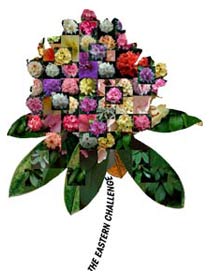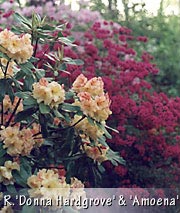Rhododendron Fortunei & Its Children
By Dr. Philip Waldman
R. fortunei was discovered in China by Robert Fortune in 1856 and named after him. It was probably the first hardy species introduced, and it is considered by many to be the finest Chinese rhododendron species. It makes an elegant 10’ specimen plant with broad oblong leaves of an attractive blue-green color and a mounded habit which tends to be slightly open and tree like. The leaves are held usually for 2 years and have a matte finish. The large 4" flowers, borne in May, are white to pale pink, often with wavy margins, and have a delightful fragrance. The trusses consist of 6-12" flowers, also of a solid texture and beautifully formed.
The plant is cold hardy to –15F and also exhibits commendable heat tolerance. It grows with excellent vigor and appears to be little bothered by pests. It has become a very popular plant for hybridizers, useful for its many virtues as well as being extremely fertile.
A particularly admirable form was used as a parent of the Loderi group in 1901, which are considered to be among the best hybrids in England. These are vigorous growing plants with huge trusses of extremely fragrant, trumpet shaped flowers of white to cream to pink. Included among them are ‘King George’, ‘Pink Diamond’ and ‘Venus.’ These plants have received numerous awards.
Charles Dexter in Sandwich, Mass., used R. fortunei extensively in his breeding program starting in 1922 and the "Dexter Hybrids" were distributed widely, many as seedlings, especially on Long Island. There are hundreds of Dexter hybrids that were named due to their hardiness, beautiful flowers, growth habit and ease of culture. Paul Vossberg of Westbury Rose Company commercially introduced several excellent Dexters in 1959, some of these selected by Howard Phipps. The new plants included ‘Scintillation’ (one of the very best), ‘Westbury’, ‘Wheatley’, ‘Brookville, ’Mrs. W.R. Coe’ and ‘Parker’s Pink.’ Many other R. fortunei Dexters are still gracing Long Island’s gardens with their beauty. Popular plants include Dexter’s ‘Appleblossom’, ‘Dexter’s Spice’, ‘Dexter’s Vanilla’ and ‘Dexter’s Peppermint’. Their fragrance enlivens our spring season.
W.R. Coe in Oyster Bay grew many Dexter seedlings and some still are seen at his former estate, now Planting Fields Arboretum. Among these are ‘Mr. W.R. Coe’, ‘Mrs. W.R. Coe’ and ‘William Coe.’ Donald Hardgrove used a hardy R. fortunei from Guy Nearing and crossed this with the tender yellow R. wardii to produce many of his unusual multi-hued rhododendrons. Still popular are ‘Golden Star’ (yellow), ‘Amazement’ (yellow) and ‘Donna Hardgrove’ (orange).
Nat Hess in Sands Point was a strong supporter of R. fortunei in hybridizing and was always commenting in its virtues. His enormous plant of R. fortunei ‘Blue Cloud’ was an awesome sight in bloom and was admired by many. Other R. fortunei hybrids introduced by Nat included ‘Dorothy Knippenberg’, ‘Dorothy Schlaikjer’ and ‘Long Island’. He also grew a plant of ‘Hardy Giant’, a Knippenberg hybrid of R. fortunei and R. fictolacteum.
Other popular R. fortunei hybrids encountered in our gardens include Paul Bosley’s ‘Brown Eyes’, Joe Gable’s ‘David Gable’, David Leach’s ‘Bravo’ and ‘Dolly Madison’, Dorothy Schlaikjer’s ‘Nathan Hale’ and ‘Halesite Maiden’, Sam Everitt’s ‘Helen Everitt’ and the R. yakusimanum – R. fortunei hybrids of ‘Nestucca’ and ‘Little White Dove.’
There are now thousands of different rhododendron varieties with R. fortunei parentage in their genes and many others on the horizon. A wonderfully useful plant with excellent garden ornamentality, R. fortunei will continue to give rise to many children.

